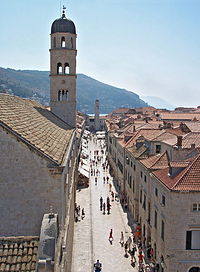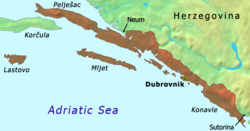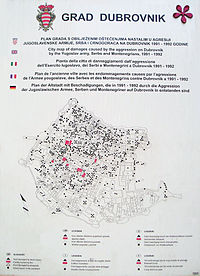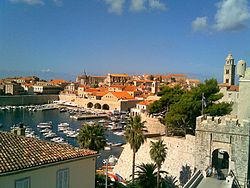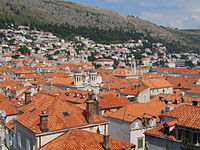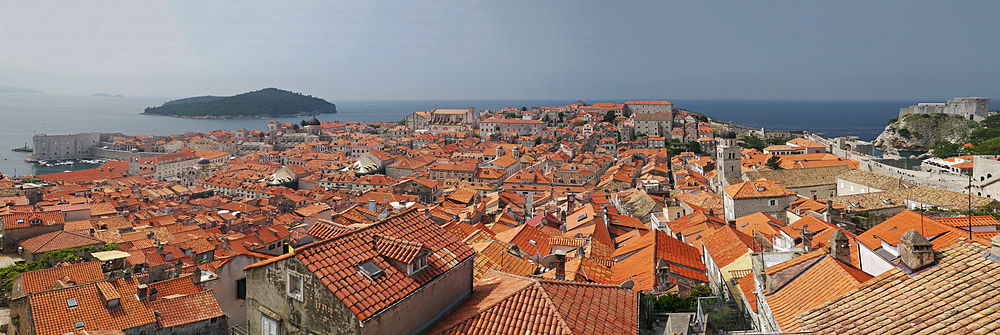- Dubrovnik
-
Dubrovnik The walled city of Dubrovnik and outskirts 
Flag
Coat of armsNickname(s): Pearl of the Adriatic, Thesaurum mundi 1995 map of Dubrovnik The location of Dubrovnik within Croatia Coordinates: 42°38′25″N 18°06′30″E / 42.64028°N 18.10833°ECoordinates: 42°38′25″N 18°06′30″E / 42.64028°N 18.10833°E Country Croatia County Dubrovnik-Neretva county Government – Mayor Andro Vlahušić (CPP) Area – City 21.35 km2 (8.2 sq mi) Population (2011)[1] – City 42,641 – Urban 28,113 Time zone CET (UTC+1) – Summer (DST) CEST (UTC+2) Postal code 20000 Area code(s) 020 Vehicle registration DU Dubrovnik (pronounced [dǔbrɔ̝ːv̞nik]; Italian: Ragusa) is a Croatian city on the Adriatic Sea coast, positioned at the terminal end of the Isthmus of Dubrovnik. It is one of the most prominent tourist destinations on the Adriatic, a seaport and the centre of Dubrovnik-Neretva county. Its total population is 42,641 (census 2011).[1] In 1979, the city of Dubrovnik joined the UNESCO list of World Heritage Sites.
The prosperity of the city of Dubrovnik has always been based on maritime trade. In the Middle Ages, as the Republic of Ragusa, also known as a Maritime Republic (together with Amalfi, Pisa, Genoa, Venice and other Italian cities), it became the only eastern Adriatic city-state to rival Venice. Supported by its wealth and skilled diplomacy, the city achieved a high level of development, particularly during the 15th and 16th centuries. Although demilitarised in the 1970s with the intent of forever protecting it from war devastation, in 1991, after the breakup of Yugoslavia, it was besieged by Serb-Montenegrin forces for 7 months and received heavy damage from shelling.
Contents
Name
In Croatian, the city is known as Dubrovnik; in Italian as Ragusa, and its historical name in Greek is Raugia (Ραυγια) or Ragousa (Ραγουσα).
The current Croatian name was officially adopted in 1918 after the fall of Austria–Hungary. It is also referred to as Dubrovnik in the first official document of the treaty with the Ban of Bosnia Ban Kulin.
History
Origins
Historical lore indicates that Ragusa (Dubrovnik) was founded in the 7th century on a rocky island named Laus, which provided shelter for Dalmatian refugees from the nearby city of Epidaurus. The Romance-Dalmatian founders were escaping from the Slavic invasions.[2]
Another theory appeared recently, based on new archaeological excavations. New findings (a Byzantine basilica from 8th century and parts of the city walls) contradict the traditional theory. The size of the old basilica clearly indicates that there was quite a large settlement at the time. There is also increasing support in the scientific community for the theory that major construction of Ragusa took place before the current era. This "Greek theory" has been boosted by recent findings of numerous Greek artefacts during excavations in the Port of Dubrovnik. Also, drilling below the main city road has revealed natural sand, contradicting the theory of Laus (Lausa) island.
Dr. Antun Ničetić, in his book "Povijest dubrovačke luke" (History of the Port of Dubrovnik), expounds the theory that Dubrovnik was established by Greek sailors. A key element in this theory is the fact that ships in ancient times travelled about 45-50 nautical miles per day, and required a sandy shore to pull out of water for the rest period during the night. The ideal rest site would have a fresh water source in its vicinity. Dubrovnik has both, and is situated almost halfway between the two known Greek settlements of Budva and Korčula (95 NM is the distance between them).
The Republic
After the fall of the Ostrogothic Kingdom, the town came under the protection of the Byzantine Empire, although it was essentially an independent city-state that actively interacted with the surrounding Croatian littoral and the Italian peninsula. Ragusa in those mediaeval centuries had a population of Latinized Illyrians, who spoke their own Dalmatian language and was an island.[3] After the Crusades, Ragusa came under the sovereignty of Venice (1205–1358), which would give its institutions to the Dalmatian city. By the Peace Treaty of Zadar in 1358, Ragusa achieved relative independence as a vassal-state of the Kingdom of Hungary.
Between the 14th century and 1808, Ragusa ruled itself as a free state, although it was a vassal from 1440 to 1804 of the Ottoman Empire and paid an annual tribute to its sultan.[4] The Republic reached its peak in the 15th and 16th centuries, when its thalassocracy rivalled that of the Republic of Venice and other Italian maritime republics.
For centuries, the Republic of Ragusa was an ally of Ancona, the other Adriatic maritime Republic rival of Venice, which was the Ottoman Empire's chief rival for control of the Adriatic. This alliance enabled the two towns set on opposite sides of the Adriatic to resist attempts by the Venetians to make the Adriatic a "Venetian Bay", also said to control directly or indirectly all the Adriatic ports. Ancona and Ragusa developed an alternative trade route to the Venetian (Venice-Germany-Austria): this route started from the East, passed through Ragusa and Ancona, then interested Florence and finally Flanders
The Republic of Ragusa received its own Statutes as early as 1272, statutes which, among other things, codified Roman practice and local customs. The Statutes included prescriptions for town planning and the regulation of quarantine (for sanitary reasons).[5]
The Republic was an early adopter of what are now regarded as modern laws and institutions: a medical service was introduced in 1301, with the first pharmacy, still operating to this day, being opened in 1317. An almshouse was opened in 1347, and the first quarantine hospital (Lazarete) was established in 1377. Slave trading was abolished in 1418, and an orphanage opened in 1432. A 20 km (12 mi) water supply system was constructed in 1436.
The city was ruled by the local aristocracy which was of Latin-dalmatian extraction and formed two city councils. As usual for the time, they maintained a strict system of social classes. The republic abolished the slave trade early in the 15th century and valued liberty highly. The city successfully balanced its sovereignty between the interests of Venice and the Ottoman Empire for centuries.
The languages spoken by the people were the Romance Dalmatian and Croatian. The latter started to replace Dalmatian little by little since the 11th century amongst the common people who inhabited the city. The aristocracy was of Latin extraction. The population itself was mostly of Latin origin until the 17th century, when Croatians migrated from the surrounding regions.
Italian and Venetian would become important languages of culture and trade in the Republic of Ragusa. The Italian language replaced Latin as official language of the Republic of Ragusa from 1472 until the end of the republic itself.[citation needed] At the same time, due to a pacific cohabitation with the Slavic element and the influence of Italian culture during the Renaissance, Ragusa became a cradle of Croatian literature.
The economic wealth of the Republic was partially the result of the land it developed, but especially of seafaring trade. With the help of skilled diplomacy, Ragusa's merchants travelled lands freely and on the sea the city had a huge fleet of merchant ships (argosy) that travelled all over the world. From these travels they founded some settlements, from India to America, and brought parts of their culture and flora home with them. One of its keys to success was not conquering, but trading and sailing under a white flag with the word Latin: Libertas(freedom) prominently featured on it. The flag was adopted when slave trading was abolished in 1418.
Many Conversos, Jews from Spain and Portugal, were attracted to the city. In May 1544, a ship landed there filled exclusively with Portuguese refugees, as Balthasar de Faria reported to King John. During this time there worked in the city one of the most famous cannon and bell founders of his time: Ivan Rabljanin (Magister Johannes Baptista Arbensis de la Tolle).
The Republic gradually declined after a crisis in Mediterranean shipping and the catastrophic earthquake of 1667[6] killed over 5,000 citizens and levelled most of the public buildings, ruining the well-being of the Republic. In 1699, the Republic sold two mainland patches of its territory to the Ottomans in order to avoid being caught in the clash with advancing Venetian forces. Today this strip of land belongs to Bosnia and Herzegovina and is that country's only direct access to the Adriatic.
In 1806, the city surrendered to the Napoleonic army,[7] as that was the only way to end a month long siege by the Russian-Montenegrin fleets (during which 3,000 cannonballs fell on the city). At first, Napoleon demanded only free passage for his troops, promising not to occupy the territory and stressing that the French were friends of the Ragusans. Later, however, French forces blockaded the harbours, forcing the government to give in and let French troops enter the city. On this day, all flags and coats of arms above the city walls were painted black as a sign of mourning. In 1808, Marshal Marmont abolished the republic and integrated its territory first into Napoleon's Kingdom of Italy and later into the Illyrian provinces under French rule.
Languages
The official language until 1472 was Latin. Later, the Senate of the Republic decided that the official language of the Republic would be the Ragusan dialect of the Romance Dalmatian language, and forbade the use of the Slavic language in senatorial debate. The Gospari (the Aristocracy) held on to their language for many centuries, while it slowly disappeared.
Although the Latin language was in official use, inhabitants of the republic were[when?] mostly native speakers of Slavonic languages (as confirmed[clarification needed] by P. A. Tolstoj in 1698, when he noted In Dalmatia... Dubrovnikans....called themselves as Ragusan(Raguseos) and always have pride in the Republic).[8] The Dalmatian language was also spoken in the city. The Italian language as spoken in the republic was heavily influenced by the Venetian language and the Tuscan dialect. Italian took root among the Dalmatian Romance-speaking merchant upper classes, as a result of Venetian influence.[9]
Austrian rule
When the Habsburg Empire gained these provinces after the 1815 Congress of Vienna, the new imperial authorities installed a bureaucratic administration, established the Kingdom of Dalmatia, which had its own Sabor (Diet) or Parliament, based in the city of Zadar, also political parties that dominated the scene were in the nineteenth century, the Autonomist Party and the People's Party. It introduced a series of modifications intended to centralize, albeit slowly, the bureaucratic, tax, religious, educational, and trade structures. Unfortunately for the local residents, these centralisation strategies, which were intended to stimulate the economy, largely failed. And once the personal, political and economic trauma of the Napoleonic Wars had been overcome, new movements began to form in the region, calling for a political reorganization of the Adriatic along national lines.[citation needed]
The combination of these two forces—a flawed Habsburg administrative system and new national movements claiming ethnicity as the founding block towards a community—created a particularly perplexing problem; for Dalmatia was a province ruled by the German-speaking, centralising Habsburg monarchy, with bilingual i.e. Slavic and Italian speaking elites that dominated a general population consisting of a Slavic Catholic majority (and a Slavic Orthodox minority of not more than 300 people).[citation needed]
In 1815, the former Ragusan Government, i.e. its noble assembly, met for the last time in the Ljetnikovac in Mokošica. Once again heavy efforts were undertaken to re-establish the Republic however this time it was all in vain. After fall of the Republic most of the aristocracy were recognized by Austrian Empire.
In 1832, Baron Sigismondo Ghetaldi-Gondola (1795–1860) was elected podestà of Ragusa, serving for 13 years; the Austrian government granted him the title of "Baron".
Count Raffaele Pozza, Dr. Jur., (1828–90) was elected for first time Podestà of Ragusa in the year 1869 after this was re-elected in 1872, 1875, 1882, 1884) and elected twice into the Dalmatian Council, 1870, 1876. The victory of the Nationalist in Spalato in 1882 had a strong echo in the areas of Curzola and Ragusa. It was greeted by the mayor (podestà) of Ragusa Raffaele Pozza, the National Reading Club of Dubrovnik, the Workers Association of Dubrovnik and the review "Slovinac"; by the communities of Kuna and Orebić, the latter one getting the nationalist government even before Split.
Austrian rule and Austro-Hungarian rule which followed lasted for more than a century and were typified by the motto of the world powers of that time: Divide et impera (Divide and rule). Austrian policy of denationalizing the Dalmatian coasts left its mark in the political division of the population as best expressed in the political parties: the Croatian People's Party and the mostly Italianite Autonomous Party.[citation needed]
In 1889, the Serbian-Catholics circle supported Baron Francesco Ghetaldi-Gondola, candidate of Autonomous Party, vs the candidate of Popular Party Vlaho de Giulli, in the 1890 election to the Dalmatian Diet.[10] The following year during the local government election, the Autonomous Party won the municipal re-election with Francesco Gondola, who died in power in 1899, the alliance won the election again on 27 May 1894. Francesco Ghetaldi-Gondola founded the Società Philately on 4 December 1890.
1921–1991
With the fall of Austria-Hungary in 1918, the city was incorporated into the new Kingdom of Serbs, Croats, and Slovenes (later the Kingdom of Yugoslavia). The name of the city was officially changed from Ragusa to Dubrovnik.
In 1921 Pero Cingrija died (born 1837), politician and one of the leaders of the People's Party in Dalmatia. It was thanks to his efforts that the People's Party and the Party of Right were fused into one Croatian Party in 1905
During World War II, Dubrovnik became part of the Nazi controlled Independent State of Croatia, occupied by the Italian army first, and by the German army after 8 September 1943. In October 1944 Tito's partisans entered Dubrovnik, that became consequently part of Communist Yugoslavia. Soon after their arrival into the city, Partisans executed approximately 78 citizens without a trial, including a Catholic priest, on the island of Daksa.[11]
Break-up of Yugoslavia
In 1991 Croatia and Slovenia, which at that time were republics within Socialist Federal Republic of Yugoslavia, declared their independence. At that event, Socialist Republic of Croatia was renamed Republic of Croatia.
Despite demilitarization of the old town in early 1970s in an attempt to prevent it from ever becoming a casualty of war, following Croatia's independence in 1991, Serbian-Montenegrin remains of the Yugoslav People's Army (JNA) attacked the city. The regime in Montenegro led by Momir Bulatović, which was installed by and loyal to the Serbian government led by Slobodan Milošević, declared that Dubrovnik would not be permitted to remain in Croatia because they claimed it was historically part of Montenegro.[12] This was in spite of the large Croat majority in the city and that very few Montenegrins resided there, though Serbs accounted for six percent of the population.[12] Many consider the claims by the Bulatović government, as being part of Serbian President Milošević's plan to deliver his nationalist supporters the Greater Serbia they desired as Yugoslavia collapsed.[12]
On October 1, 1991 Dubrovnik was attacked by JNA with a siege of Dubrovnik that lasted for seven months. Heaviest artillery attack happened on December 6 with 19 people killed and 60 wounded. Total casualties in the conflict according to Croatian Red Cross were 114 killed civilians, among them celebrated poet Milan Milisić. Foreign newspapers have been criticised for exaggerating the damage sustained by the old town, instead of responding to human casualties.[13] Nonetheless, the artillery attacks on Dubrovnik damaged 56% of its buildings to some degree, as the historic walled city, a UNESCO world heritage site, sustained 650 hits by artillery rounds.[14] In May 1992 the Croatian Army lifted the siege and liberated Dubrovnik's surroundings, but the danger of sudden attacks by the JNA lasted for another three years.[15]
Following the end of the war, damage caused by the shelling of the Old Town was repaired. Adhering to UNESCO guidelines, repairs were performed in the original style. As of 2005[update], most damage had been repaired. The inflicted damage can be seen on a chart near the city gate, showing all artillery hits during the siege, and is clearly visible from high points around the city in the form of the more brightly coloured new roofs. ICTY indictments were issued for JNA generals and officers involved in the bombing.
General Pavle Strugar, who coordinated the attack on the city, was sentenced to an eight year prison term by the International Criminal Tribunal for the former Yugoslavia for his role in the attack.
The 1996 Croatia USAF CT-43 crash, near Dubrovnik Airport, killed everyone on a United States Air Force jet with United States Secretary of Commerce Ron Brown, The New York Times Frankfurt Bureau chief Nathaniel C. Nash and 33 other people.
Heritage
Old City of Dubrovnik The Old Harbour at DubrovnikLocation: Dubrovnik-Neretva County,  Croatia
CroatiaUNESCO World Heritage Site Type: Cultural Criteria: i, iii, iv Designated: 1979 (3rd Session) Reference #: 95 Extension: 1994 Endangered: 1991-1998 Cultural Good of Croatia Official name: Stari grad Dubrovnik The annual Dubrovnik Summer Festival is a 45 day-long cultural event with live plays, concerts, and games. It has been awarded a Gold International Trophy for Quality (2007) by the Editorial Office in collaboration with the Trade Leaders Club.
The patron saint of the city is Sveti Vlaho (Saint Blaise), whose statues are seen around the city. He has an importance similar to that of St. Mark the Evangelist to Venice. One of the larger churches in city is named after Saint Blaise. February 3 is the feast of Sveti Vlaho (Saint Blaise), who is the city's patron saint. Every year the city of Dubrovnik celebrates the holiday with Mass, parades, and festivities that last for several days.[16]
The Old Town of Dubrovnik is depicted on the reverse of the Croatian 50 kuna banknote, issued in 1993 and 2002.[17]
The city boasts of many old buildings, such as the Arboretum Trsteno, the oldest arboretum in the world, dating back to before 1492. Also, the third oldest European pharmacy is located in the city, which dates back to 1317 (and is the only one still in operation today). It is located at Little Brothers monastery in Dubrovnik.[18]
In history, many Conversos (Marranos) were attracted to Dubrovnik, formerly a considerable seaport. In May, 1544, a ship landed there filled exclusively with Portuguese refugees, as Balthasar de Faria reported to King John. Another admirer of Dubrovnik, George Bernard Shaw, visited the city in 1929 and said: "If you want to see heaven on earth, come to Dubrovnik."
In the bay of Dubrovnik is the 72-hectare wooded island of Lokrum, where according to legend, Richard the Lionheart was cast ashore after being shipwrecked in 1192. The island includes a fortress, botanical garden, monastery and naturist beach.
Among the many tourist destinations are a few beaches. Banje, Dubrovnik's main public beach, is home to the Eastwest Beach Club. There is also Copacabana Beach, a small stony beach part of the Elaphiti Islands,[19] named after the popular beach in Rio de Janeiro.
Dubrovnik has also been mentioned in popular film and theatre. In the film 20,000 Leagues Under the Sea with Michael Caine, one of the characters said to have been dreaming of fairy from Dubrovnik (motive known from local legends and literature).
Ivan Gundulić, a 17th century Croatian writer, predicted the downfall of the great Turkish Empire in his poem Osman.
Important monuments
Few of Dubrovnik's Renaissance buildings survived the earthquake of 1667 but fortunately enough remain to give an idea of the city's architectural heritage.[20] The finest Renaissance highlight is the Sponza Palace which dates from the 16th century and is currently used to house the National Archives.[21] The Rectors Palace is a Gothic-Renaissance structure that displays finely carved capitals and an ornate staircase. It now houses a museum.[22][23] Its façade is depicted on the reverse of the Croatian 50 kuna banknote, issued in 1993 and 2002.[17] The St. Saviour Church is another remnant of the Renaissance period, next to the much-visited Franciscan Monastery.[18][24][25] The Franciscan monastery's library possesses 30,000 volumes, 22 incunabula, 1,500 valuable handwritten documents. Exhibits include a 15th century silver-gilt cross and silver thurible, an 18th century crucifix from Jerusalem, a martyrology (1541) by Bemardin Gucetic and illuminated psalters.[18]
Dubrovnik's most beloved church is St Blaise's church, built in the 18th century in honour of Dubrovnik's patron saint. Dubrovnik's baroque Cathedral was built in the 18th century and houses an impressive Treasury with relics of Saint Blaise. The city's Dominican Monastery resembles a fortress on the outside but the interior contains an art museum and a Gothic-Romanesque church.[26][27] A special treasure of the Dominican monastery is its library with over 220 incunabula, numerous illustrated manuscripts, a rich archive with precious manuscripts and documents and an extensive art collection.[28][29][30]
Walls of Dubrovnik
Main article: Walls of DubrovnikA feature of Dubrovnik is its walls that run almost 2 km (1.24 mi) around the city. The walls run from four to six metres thick on the landward side but are much thinner on the seaward side. The system of turrets and towers were intended to protect the vulnerable city.[31]
Demographics
The total population of the city is 42,641 (census 2011), in the following settlements:[1]
- Bosanka, population 139
- Brsečine, population 99
- Čajkovica, population 149
- Čajkovići, population 24
- Donje Obuljeno, population 210
- Dubravica, population 37
- Dubrovnik, population 28,113
- Gornje Obuljeno, population 121
- Gromača, population 141
- Kliševo, population 55
- Knežica, population 120
- Koločep, population 165
- Komolac, population 313
- Lopud, population 249
- Lozica, population 136
- Ljubač, population 62
- Mokošica, population 1,946
- Mravinjac, population 80
- Mrčevo, population 86
- Nova Mokošica, population 5,921
- Orašac, population 625
- Osojnik, population 297
- Petrovo Selo, population 22
- Pobrežje, population 121
- Prijevor, population 441
- Rožat, population 339
- Suđurađ, population 203
- Sustjepan, population 306
- Šipanska Luka, population 211
- Šumet, population 173
- Trsteno, population 221
- Zaton, population 1,001
The population was 43,770 in 2001,[32] down from 49,728 in 1991.[33] In the 2001 census, approximately 88.39% of the population was Croat.[32]
However, by the Summer of 2011, barely 20 years after the War, the population within the old city walls had dwindled to about 1,000 people, most of them elderly. Many Croats fear that the city will turn into a ghost town catering to tourists only.
Transport
Dubrovnik has an international airport of its own. It is located approximately 20 km (12 mi) from Dubrovnik city centre, near Čilipi. Buses connect the airport with the Dubrovnik old main bus station in Gruž. In addition, a network of modern, local buses connects all Dubrovnik neighbourhoods running frequently from dawn to midnight. However, Dubrovnik, unlike Croatia's other major centres, is not accessible by rail.[34] Until 1975 Dubrovnik was connected to Mostar and Sarajevo by a narrow gauge railway(760 mm)[35][36] built during the Austro-Hungarian rule of Bosnia.
The A1 highway, in use between Zagreb and Vrgorac, is planned to be extended all the way to Dubrovnik. The highway will cross the Pelješac Bridge which is currently under construction. An alternative plan proposes the highway running from Neum through Bosnia and Herzegovina and an expressway continuing to Dubrovnik. However, this plan has fallen out of favour.
Education
Dubrovnik has a number of educational institutions. These include Dubrovnik International University, the University of Dubrovnik, a Nautical College, a Tourist College, a University Centre for Postgraduate Studies of the University of Zagreb, American College of Management and Technology, and an Institute of History of the Croatian Academy of Sciences and Arts.
Climate
The climate along the Dubrovnik Region is a typical Mediterranean one, with mild, rainy winters and hot and dry summers. However, it is perhaps distinct from other Mediterranean climates because of the unusual winds and frequency of thunderstorms. The Bura wind blows uncomfortably cold gusts down the Adriatic coast between October and April, and thundery conditions are common all the year round, even in summer, when they interrupt the warm, sunny days. The air temperatures can slightly vary, depending on the area or region. Typically, in July and August daytime maximum temperatures reach 29 °C (84 °F), and at night drop to around 21 °C (70 °F). More comfortable, perhaps, is the climate in Spring and Autumn when maximum temperatures are typically between 20 °C (68 °F) and 28 °C (82 °F).
Climate data for Dubrovnik Month Jan Feb Mar Apr May Jun Jul Aug Sep Oct Nov Dec Year Average high °C (°F) 13.2
(55.8)13.3
(55.9)14.4
(57.9)16.9
(62.4)21.3
(70.3)25.2
(77.4)28.8
(83.8)28.9
(84.0)25.4
(77.7)21.4
(70.5)16.6
(61.9)13.3
(55.9)19.7 Average low °C (°F) 7.0
(44.6)7.4
(45.3)8.5
(47.3)10.9
(51.6)15.2
(59.4)18.8
(65.8)22.7
(72.9)22.5
(72.5)18.7
(65.7)15.2
(59.4)10.8
(51.4)7.8
(46.0)13.5 Precipitation mm (inches) 95.2
(3.748)89.2
(3.512)97.7
(3.846)90.9
(3.579)76.1
(2.996)48.6
(1.913)24.1
(0.949)59.0
(2.323)78.7
(3.098)109.9
(4.327)141.0
(5.551)125.3
(4.933)1,035.7
(40.776)Avg. precipitation days 11.2 10.9 11.6 11.2 9.5 6.7 4.4 4.5 6.4 10.3 11.3 12.5 110.5 Sunshine hours 127.1 130.5 155.0 186.0 251.1 294.0 356.5 347.2 261.0 204.6 108.0 99.2 2,520.2 Source: World Meteorological Organization (UN),[37] climatetemp.info[38] for data of sunshine hours - Air temperature
- average annual
- 16.4 °C (61.5 °F)
-
- average of coldest period = January
- 10 °C (50 °F)
- average of warmest period = August
- 25.8 °C (78.4 °F)
-
- Sea temperature
- average May–September
- 17.9–23.8 °C (64–75 °F)
- Salinity*
- approximately 38 ‰ (parts per thousand)
- Precipitation
- average annual
- 1,020.8 mm
-
- average annual rain days
- 109.2
- Sunshine
- average annual
- 2629 h
-
- average daily hours
- 7.2 h
International relations
See also: List of twin towns and sister cities in CroatiaTwin towns - sister cities
Dubrovnik is twinned with:[39]
 Helsingborg, Sweden (since 1996)[39]
Helsingborg, Sweden (since 1996)[39] Ragusa, Italy (since 2000)[39]
Ragusa, Italy (since 2000)[39] Bad Homburg, Germany (since 2002)[39]
Bad Homburg, Germany (since 2002)[39]
 Sarajevo, Bosnia and Herzegovina (since 2007)[39]
Sarajevo, Bosnia and Herzegovina (since 2007)[39] Monterey, California, United States (since 2007)[39]
Monterey, California, United States (since 2007)[39] Rueil-Malmaison, France since (2011)[42]
Rueil-Malmaison, France since (2011)[42]
Images
Panorama
Gallery
-
The Roland statue, symbol of a free city
See also
- List of people from Dubrovnik
- Walls of Dubrovnik
- Republic of Ragusa
- Dalmatia
References
Bibliography
- Cresswell, Peterjon; Atkins, Ismay; Dunn, Lily (10 July 2006). Time Out Croatia (First ed.). London, Berkeley & Toronto: Time Out Group Ltd & Ebury Publishing, Random House Ltd. 20 Vauxhall Bridge Road, London SV1V 2SA. ISBN 9781904978701. http://books.google.com/books?id=VZweAAAACAAJ. Retrieved 10 March 2010.
- Harris, Robin. Dubrovnik, A History. London: Saqi Books, 2003. ISBN 0-86356-332-5
- Kremenjaš-Daničić, Adriana (Editor-in-Chief): Roland's European Paths. Dubrovnik: Europski dom Dubrovnik, 2006. ISBN 953-95338-0-5
- Marko Kovac (2/4/2003). "Dubrovnik’s Heritage Under Threat". BBC. http://news.bbc.co.uk/2/hi/europe/2716347.stm.
- Frank McDonald (July 18, 2008). "The 'Pearl' Loses its Luster". Irish Times. http://www.irishtimes.com/newspaper/features/2008/0718/1216073242375.html.
- Frank McDonald (July 18, 2008). "Will Greed Tarnish Croatia's Gem?". Irish Times. http://www.irishtimes.com/newspaper/features/2008/0718/1216073242375.html.
Notes
- ^ a b c "Census of Population, Households and Dwellings 2011, First Results by Settlements" (in Croatian and English) (HTML). Statistical Reports (Zagreb: Croatian Bureau of Statistics) (1441). June 2011. ISSN 1332-0297. http://www.dzs.hr/Eng/censuses/census2011/htm/E11_Zup37_0981.html. Retrieved 2011-09-15.
- ^ Researches on the Danube and the Adriatic by Andrew Archibald Paton (1861). Contributions to the Modern History of Hungary and Transylvania, Dalmatia and Croatia, Servia and Bulgaria-Brockhaus Chapter 9. page 218
- ^ Ragusa was an island originally
- ^ Donald Edgar Pitcher, An Historical Geography of the Ottoman Empire (Leiden: Brill, 1968), p. 70
- ^ Naklada Naprijed, The Croatian Adriatic Tourist Guide, pg. 354, Zagreb (199), ISBN 953-178-097-8
- ^ Earthquake Monitoring and Seismic Hazard Mitigation in Balkan Countries by Eystein Sverre Husebye
- ^ Dalmatia and Montenegro: Volume 2 by Sir John Gardner Wilkinson
- ^ (Croatian) Jezik, lingvistika i politika: Ilirski iliti slovinki jezik[dead link]
- ^ (Italian) Marzio, Scaglioni (1996). "La presenza italiana in Dalmazia, 1866-1943". Tesi di Laurea. Facoltà di Scienze politiche - Università degli studi di Milano. Archived from the original on 2010-02-17. http://www.webcitation.org/5nbG01IRn. Retrieved 2010-02-17.
- ^ Trudna tożsamość: problemy ... - Búsqueda de libros de Google. Books.google.cl. 2007-09-20. http://books.google.cl/books?lr=&id=GOVJAAAAMAAJ&dq=dubrovnik+gondola&q=gondola&pgis=1. Retrieved 2009-05-05.
- ^ "Nakon ulaska partizana u Dubrovnik u listopadu 1944.: Partizani pogubili hrvatske antifašiste | Izdvojeno | Glas Koncila". Glas-koncila.hr. http://www.glas-koncila.hr/rubrike_izdvojeno.html?news_ID=11154. Retrieved 2008-11-11.
- ^ a b c Srđa Pavlović. "Pavlovic: The Siege of Dubrovnik". Yorku.ca. Archived from the original on 2010-02-15. http://www.webcitation.org/5nYLi2zaI. Retrieved 2008-11-11.
- ^ Joseph Pearson, 'Dubrovnik’s Artistic Patrimony, and its Role in War Reporting (1991)' in European History Quarterly, Vol. 40, No. 2, 197-216 (2010). http://ehq.sagepub.com/cgi/content/abstract/40/2/197
- ^ "Chronology for Serbs in Croatia". United Nations High Commissioner for Refugees. 2004. http://www.unhcr.org/refworld/country,,,CHRON,HRV,,469f387dc,0.html. Retrieved January 5, 2011.
- ^ Raymond Bonner (August 17, 1995). "Dubrovnik Finds Hint of Deja Vu in Serbian Artillery". The New York Times. http://www.nytimes.com/1995/08/17/world/dubrovnik-finds-hint-of-deja-vu-in-serbian-artillery.html?ref=croatia. Retrieved December 18, 2010.
- ^ Dubrovnik news
- ^ a b Croatian National Bank. Features of Kuna Banknotes: 50 kuna (1993 issue) & 50 kuna (2002 issue). – Retrieved on 30 March 2009.
- ^ a b c "Monuments (1 to 5)". Dubrovnik Online. Archived from the original on 2010-02-16. http://www.webcitation.org/5nZfoXB6a. Retrieved 2010-02-16.
- ^ Karen Tormé Olson, Sanja Bazulic Olson (2006). Frommer's Croatia. John Wiley & Sons. pp. 57–58. ISBN 0764598988. http://books.google.ca/books?id=ue-4o37AficC&pg=PA57. Retrieved 27 October 2009.
- ^ Oliver, Jeanne. "Dubrovnik Sights". Croatia Traveller. Archived from the original on 2010-02-16. http://www.webcitation.org/5nZcXdGut. Retrieved 2010-02-16.
- ^ "Sponza Palace". DubrovnikCity.com. Archived from the original on 2010-02-16. http://www.webcitation.org/5nZd5Sp5D. Retrieved 2010-02-16.
- ^ "The Rector's Palace". DubrovnikCity.com. Archived from the original on 2010-02-16. http://www.webcitation.org/5nZdcJwZn. Retrieved 2010-02-16.
- ^ "The Rector's Palace". Dubrovnik Guide. Archived from the original on 2010-02-16. http://www.webcitation.org/5nZdliVBO. Retrieved 2010-02-16.
- ^ "Franciscan monastery". Dubrovnik Guide. Archived from the original on 2010-02-16. http://www.webcitation.org/5nZex4dgy. Retrieved 2010-02-16.
- ^ "Franciscan Friary, Dubrovnik". Sacred Destinations. Archived from the original on 2010-02-16. http://www.webcitation.org/5nZfE54l4. Retrieved 2010-02-16.
- ^ "Church of St. Blaise, Dubrovnik". Sacred Destinations. Archived from the original on 2010-02-16. http://www.webcitation.org/5nZgkO04Q. Retrieved 2010-02-16.
- ^ "Monuments (16 to 20)". Dubrovnik Online. Archived from the original on 2010-02-16. http://www.webcitation.org/5nZgalc2L. Retrieved 2010-02-16.
- ^ "Dominican Friary, Dubrovnik". Sacred Destinations. Archived from the original on 2010-02-16. http://www.webcitation.org/5nZfQyvhE. Retrieved 2010-02-16.
- ^ Oliver, Jeanne. "Dominican Monastery". Croatia Traveller. Archived from the original on 2010-02-16. http://www.webcitation.org/5nZhbUmeY. Retrieved 2010-02-16.
- ^ "Monuments (21 To 22)". Dubrovnik Online. Archived from the original on 2010-02-16. http://www.webcitation.org/5nZhwi079. Retrieved 2010-02-16.
- ^ Oliver, Jeanne. "Dubrovnik's Walls". Croatia Traveller. Archived from the original on 2010-02-16. http://www.webcitation.org/5nZiU3E3K. Retrieved 2010-02-16.
- ^ a b "Population by ethnicity, by towns/municipalities, census 2001". Croatian Bureau of Statistics. 2001. Archived from the original on 2008-12-03. http://wikiwix.com/cache/?url=http://www.dzs.hr/Eng/censuses/Census2001/Popis/E01_02_02/E01_02_02_zup19.html. Retrieved 2011-09-15.
- ^ "Encyclopedia, Dubrovnik". A&E Television Networks, History.com. Funk & Wagnalls' New Encyclopedia. World Almanac Education Group. Archived from the original on 2010-02-14. http://www.webcitation.org/5nX41WakL. Retrieved 2010-02-14.
- ^ "Transportation Rail". Dubrovnik Online. http://www.dubrovnik-online.com/english/transportation_rail.php. Retrieved 20 June 2009.
- ^ "Dubrovnik to Sarajevo 1965". Charlie Lewis. http://www.penmorfa.com/JZ/dubrovnik2.html. Retrieved 27 Sept 2011.
- ^ "Dubrovnik to Capljina in 1972". Jim Horsford. http://www.penmorfa.com/JZ/jhorsford.html. Retrieved 27 Sept 2011.
- ^ "Weather Information for Dubrovnik". http://www.worldweather.org/019/c00074.htm.
- ^ "Dubrovnik Weather Averages". http://www.climatetemp.info/croatia/dubrovnik.html.
- ^ a b c d e f g h i "Gradovi prijatelji Grada Dubrovnika" (in Croatian). Grad Dubrovnik. http://www.dubrovnik.hr/dubrovnik_info.php. Retrieved 2009-08-26.[dead link]
- ^ Grad Vukovar (2011 [last update]). "Gradovi prijatelji". vukovar.hr. http://www.vukovar.hr/gradovi-prijatelji.html. Retrieved 28 September 2011.
- ^ "Twin Towns - Graz Online - English Version". www.graz.at. http://www.graz.at/cms/beitrag/10045157/606819/. Retrieved 2010-01-05.
- ^ 29.01.2011. 20:45 (2011-01-29). "Dubrovnik se pobratimio s francuskim Rueil-Malmaisonom – Grad Dubrovnik — Dubrovački vjesnik". Dubrovacki.hr. http://www.dubrovacki.hr/clanak/25962/dubrovnik-se-pobratimio-s-francuskim-rueil-malmaisonom. Retrieved 2011-06-02.
External links
- Old City of Dubrovnik - UNESCO World Heritage Centre
- Dubrovnik, pearl of the Adriatic Photo gallery and tourist information
- Dubrovnik travel guide from Wikitravel
- Video, Dubrovnik Digital reconstruction by GRAIL at Washington University
- eGuide to Dubrovnik Churches and Monasteries
- Dubrovnik in Encyclopedia Britannica
- Guide to Dubrovnik history, famous people, culture and monuments
Subdivisions of Dubrovnik-Neretva County Cities and towns Municipalities Cities and major settlements of Croatia by population 100,000+ 35,000+ 10,000+ Beli Manastir · Belišće · Benkovac · Čakovec · Crikvenica · Đakovo · Daruvar · Duga Resa · Dugo Selo · Garešnica · Gospić · Imotski · Ivanec · Ivanić-Grad · Jastrebarsko · Kastav · Knin · Koprivnica · Krapina · Križevci · Kutina · Labin · Makarska · Metković · Našice · Nova Gradiška · Novi Marof · Novska · Ogulin · Omiš · Opatija · Petrinja · Pleternica · Ploče · Poreč · Požega · Rovinj · Sinj · Slatina · Solin · Sveta Nedelja · Sveti Ivan Zelina · Trogir · Umag · Valpovo · Virovitica · Vrbovec · Vukovar · Zaprešić · ŽupanjaWorld Heritage Sites in Croatia Cathedral of St. James, Šibenik · Dubrovnik · Episcopal Complex of the Euphrasian Basilica, Poreč · Plitvice Lakes · Split with the Palace of Diocletian · Stari Grad Plain · Trogir
Maritime republics  Categories:
Categories:- Dubrovnik
- Cities and towns in Croatia
- Populated coastal places in Croatia
- Populated places in Dubrovnik-Neretva County
- Maritime Republics
- World Heritage Sites in Croatia
- Walled towns
- Port cities and towns of the Adriatic Sea
Wikimedia Foundation. 2010.




